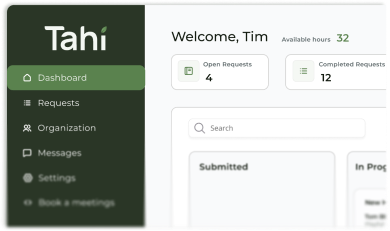Scope Creep
Scope creep is the uncontrolled expansion of a project's requirements beyond the original agreement, often leading to budget overruns and timeline delays.
What is scope creep and why should businesses be concerned about it?
Scope creep refers to the gradual expansion of a project beyond its original boundaries and agreed-upon requirements. It typically happens through small, seemingly innocent additions that accumulate over time. A client might ask to 'just add one more page' or 'quickly include another feature', and while each individual request seems reasonable, collectively they can transform a well-defined project into something completely different from what was originally planned and budgeted.
For businesses, scope creep represents a serious threat to both budget and timeline. What starts as a predictable investment can spiral into unexpected costs and delayed launches. More concerning is the impact on quality. When projects constantly expand without proper planning, the original objectives can become diluted, and the final product may lack the focus and polish that drives real business results. Scope creep often leads to rushed implementations and compromised user experiences.
How does scope creep typically develop in web design projects?
Scope creep often begins innocently during the excitement of seeing designs come to life. As stakeholders review Figma prototypes or early Webflow development, new ideas naturally emerge. A competitor launches a feature that suddenly seems essential, market feedback suggests a different direction, or team members who weren't involved in initial planning contribute their perspectives.
The problem compounds when project requirements aren't clearly documented from the start. Without a detailed scope and approval process, it becomes difficult to distinguish between necessary refinements and genuine scope expansion. Small requests accumulate gradually, and by the time the impact becomes apparent, the project has often grown significantly beyond its original parameters. This gradual expansion can strain budgets, extend timelines, and create tension between teams who have different expectations about what was included in the original agreement.
How can thorough planning prevent scope creep?
The most effective defence against scope creep is comprehensive planning and clear documentation before any design or development work begins. This starts with detailed project requirements that outline exactly what will be delivered, including specific pages, features, and functionality. A thorough design phase in Figma allows stakeholders to see and interact with the complete user experience before development begins.
Creating a detailed prototype serves as a visual contract that everyone can understand and approve. When changes are suggested later, they can be evaluated against this approved baseline, making it clear whether they represent refinements within scope or genuine additions that require separate consideration. This clarity prevents misunderstandings and ensures that any scope changes are made consciously and strategically rather than gradually and accidentally through our systematic approach.
Can a subscription model help manage scope more effectively?
A well-designed subscription model fundamentally changes the relationship with new ideas and requests. Instead of treating every suggestion as potential scope creep that requires contract amendments and budget renegotiation, a subscription framework views new requests as simply the next items in the project queue. This transforms the dynamic from restriction to flexibility.
With a structured task management system, new ideas can be captured, evaluated, and prioritised without disrupting current work or creating budget surprises. Clients can add requests to their queue and prioritise them according to business needs, while the team maintains focus on completing current tasks. This approach provides the agility that modern businesses need while maintaining project discipline and quality standards through our systematic process.
How does Tahi Studio help clients navigate scope challenges effectively?
At Tahi Studio, we believe that clear communication and systematic processes are the best defences against scope confusion. Our approach starts with comprehensive planning and detailed prototyping that gives everyone a crystal-clear understanding of what will be built. This initial investment in clarity prevents most scope issues from arising in the first place.
Our subscription model then provides the flexibility to adapt and evolve without the friction typically associated with scope changes. New ideas are welcomed and managed through our transparent dashboard system, allowing projects to remain agile while maintaining focus and quality. This approach transforms scope management from a source of tension into a tool for continuous improvement, supporting your business's need to adapt while delivering consistent, high-quality results.







